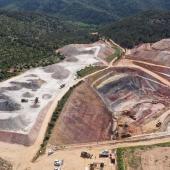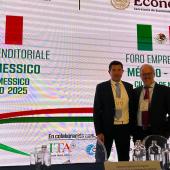Grupo Lamosa sees slowdown in first quarter
Following exceptional growth in 2022, Grupo Lamosa reported a 6% decline in revenue in the first quarter of the current year compared to the same period last year. The group’s financial structure remains solid.

Grupo Lamosa’s financial results in the first quarter of 2023 were impacted by the volatile global macroeconomic environment coupled with a slackening of markets as demand returned to its normal pre-pandemic levels. Sales fell by 6% compared to the same quarter in 2022 to MX$8.3 billion (more than €421 million at the 31/3/23 exchange rate).
The San Pedro Garza García-based multinational, Mexico’s largest ceramic tile manufacturer and one of the top three global players, continued to generate the majority of its revenues (60%) in the domestic market with sales of MX$4.97 billion, down 4% on the first quarter of the previous year. However, the slowdown was most significant in export markets, where the group reported a 9% decline in sales to MX$3.33 billion in the first quarter of 2023 compared to MX$3.6 billion in the same period in 2022.
Lower revenues combined with higher costs and expenses reduced the absorption of fixed costs and impacted operating margin or EBITDA (down 20% to MX$1.82 billion) and consequently operating income EBIT (down 26% to MX$1.51 billion). Inevitably, this also impacted net income, which fell by 31% to MX$1.09 billion.
Sales in the floor and wall tile business (which accounts for 73% of the group’s total sales) contributed to the negative first-quarter result, dropping by 9% compared to the first quarter of 2022 to MX$6.05 billion (about €307 million). This business was hit by the reduction in demand in all countries in which Grupo Lamosa operates: Mexico, Colombia, Peru, Argentina, Chile, Brazil and Spain, as well as the United States.
The adhesives business, which accounts for 27% of total group sales, posted 3% growth in revenues to MX$2.25 billion (compared to MX$2.17 billion in the first quarter of 2022) following incorporation of Fanosa operations.
Despite the slowdown in business, the group led by Federico Toussaint Elosúa continued its investment plan in the first three months of the year with a total of MX$485 million (more than €25 million) invested primarily in capacity expansions and technology upgrades for its various plants and in information technologies.
In the first three months of the current year, Grupo Lamosa continued the process of consolidating and optimising the acquisitions of Fanosa and Roca Tiles that began in 2022, a truly exceptional year for the group in terms of its economic and financial performance.
All indicators point to upward trend in 2022

The integration of Roca Tiles and Fanosa, which were acquired in September 2021 and January 2022 respectively, made a big contribution to the sales growth reported by the Mexican group last year.
“The incorporation of the new businesses is an ongoing process but, as with previous acquisitions, is going in the right direction, and in some cases even generating better-than-expected results,” said Chairman and CEO Federico Toussaint Elosúa.
In 2022, consolidated sales reached MX$35.4 billion (approximately €1.7 billion at the 31/12/22 exchange rate), an increase of 30% over 2021 and 97.5% compared to 2019.
The floor and wall tile business grew by 22% to MX$26.4 billion (about €1.27 billion) with an output volume of 213 million sqm. Revenues in the adhesives business grew by 61% to almost MX$9 billion.
EBITDA likewise saw double-digit growth, up 10% to MX$8.1 billion.
In 2022, total investments amounted to more than MX$4 billion (€192 million), partly for the acquisition of Fanosa and partly for the modernisation of production facilities.
During the year, the group also implemented several initiatives aimed at meeting the ESG objectives set out in its environmental sustainability plan, including optimising energy use, reducing emissions and operating in accordance with circularity criteria in the design of processes, products and services, while minimising the production of waste.
Thanks to its development and diversification strategy, the group has succeeded in doubling its size in the last four years by expanding its presence in nine Latin American and European countries and maintaining a sufficiently solid financial structure to continue driving future growth.
Did you find this article useful?
Join the CWW community to receive the most important news from the global ceramic industry every two weeks
























